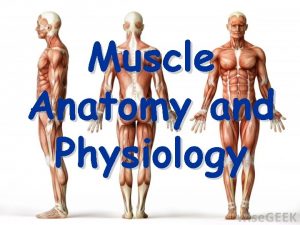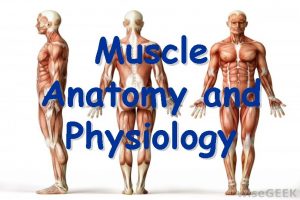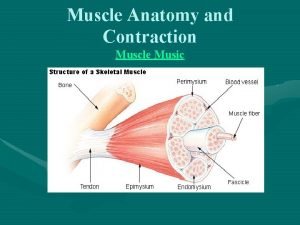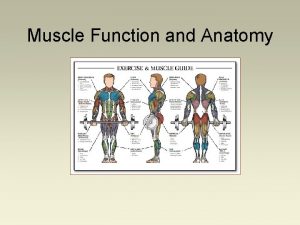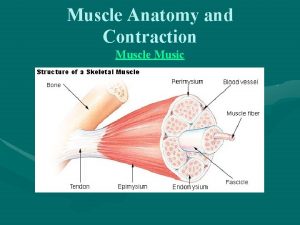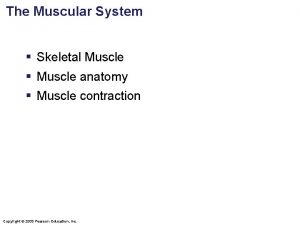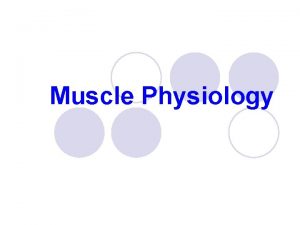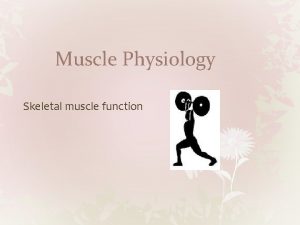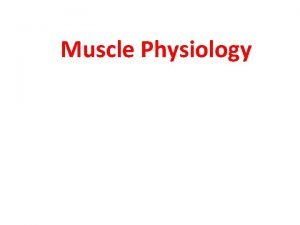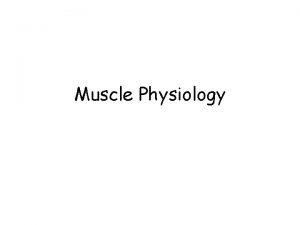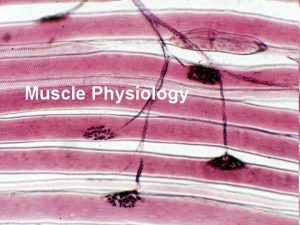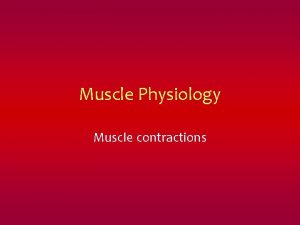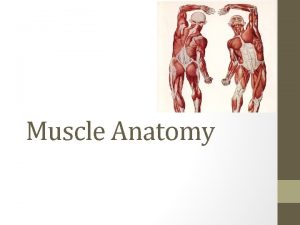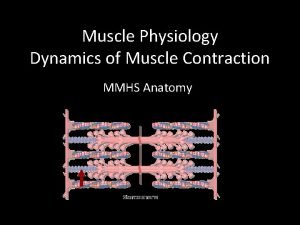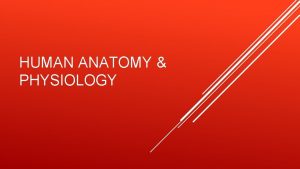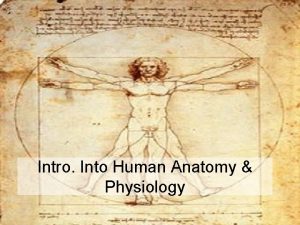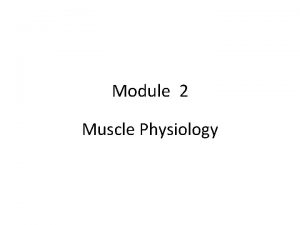Muscle Physiology Human Anatomy and Physiology II Oklahoma














































- Slides: 46

Muscle Physiology Human Anatomy and Physiology II Oklahoma City Community College Dennis Anderson

Muscle Tissue • Skeletal Muscle • Cardiac Muscle • Smooth Muscle

Skeletal Muscle • • • Long cylindrical cells Many nuclei per cell Striated Voluntary Rapid contractions

Cardiac Muscle • • • Branching cells One or two nuclei per cell Striated Involuntary Medium speed contractions

Smooth Muscle • • • Fusiform cells One nucleus per cell Nonstriated Involuntary Slow, wave-like contractions

Microanatomy of Skeletal Muscle


Z line




H Band

Sarcomere Relaxed

Sarcomere Partially Contracted

Sarcomere Completely Contracted



Binding Site Troponin Tropomyosin

Myosin


Neuromuscular Junction


Acetylcholine Opens Na+ Channel


Muscle Contraction Summary • Nerve impulse reaches myoneural junction • Acetylcholine is released from motor neuron • Ach binds with receptors in the muscle membrane to allow sodium to enter • Sodium influx will generate an action potential in the sarcolemma

Muscle Contraction Continued • Action potential travels down T tubule • Sarcoplamic reticulum releases calcium • Calcium binds with troponin to move the troponin, tropomyosin complex • Binding sites in the actin filament are exposed

Muscle Contraction Continued • Myosin head attach to binding sites and create a power stroke • ATP detaches myosin heads and energizes them for another contaction • When action potentials cease the muscle stop contracting

Motor Unit All the muscle cells controlled by one nerve cell

Motor Unit Ratios • Back muscles – 1: 100 • Finger muscles – 1: 10 • Eye muscles – 1: 1

ATP

Creatine • Molecule capable of storing ATP energy Creatine + ATP Creatine phosphate + ADP

Creatine Phosphate • Molecule with stored ATP energy Creatine phosphate + ADP Creatine + ATP

Muscle Fatique • Lack of oxygen causes ATP deficit • Lactic acid builds up from anaerobic respiration

Muscle Atrophy • Weakening and shrinking of a muscle • May be caused – Immobilization – Loss of neural stimulation

Muscle Hypertrophy • Enlargement of a muscle • More capillaries • More mitochondria • Caused by – Strenuous exercise – Steroid hormones

Steroid Hormones • Stimulate muscle growth and hypertrophy

Muscle Tonus • Tightness of a muscle • Some fibers always contracted

Tetany • Sustained contraction of a muscle • Result of a rapid succession of nerve impulses

Tetanus

Refractory Period • Brief period of time in which muscle cells will not respond to a stimulus

Refractory

Refractory Periods Skeletal Muscle Cardiac Muscle

Isometric Contraction • Produces no movement • Used in – Standing – Sitting – Posture

Isotonic Contraction • Produces movement • Used in – Walking – Moving any part of the body

Myoglobin • Oxygen carrying protein related to hemoglobin • Found in skeletal & cardiac muscle • Store O 2 • Allows for organisms to hold their breath longer • May be found in blood stream if muscles have been damaged ex: after a heart atta

THE END
 Human anatomy and physiology seventh edition marieb
Human anatomy and physiology seventh edition marieb Waistline
Waistline Holes essential of human anatomy and physiology
Holes essential of human anatomy and physiology Medial lateral distal proximal
Medial lateral distal proximal Chapter 2 human reproductive anatomy and physiology
Chapter 2 human reproductive anatomy and physiology Uterus perimetrium
Uterus perimetrium Anatomy and physiology edition 9
Anatomy and physiology edition 9 Respiratory physiology
Respiratory physiology Tattoo anatomy and physiology
Tattoo anatomy and physiology Science olympiad anatomy and physiology
Science olympiad anatomy and physiology Crown plants examples
Crown plants examples Bone metabolism
Bone metabolism Duodenal ulcer anatomy
Duodenal ulcer anatomy Sheep liver lobes
Sheep liver lobes Epigastric region
Epigastric region Wpigastric region
Wpigastric region Google.com
Google.com The central sulcus divides which two lobes? (figure 14-13)
The central sulcus divides which two lobes? (figure 14-13) Http://anatomy and physiology
Http://anatomy and physiology Appendix physiology
Appendix physiology Aohs foundations of anatomy and physiology 1
Aohs foundations of anatomy and physiology 1 Aohs foundations of anatomy and physiology 1
Aohs foundations of anatomy and physiology 1 Anatomy and physiology of swine
Anatomy and physiology of swine Anatomy and physiology chapter 8 special senses
Anatomy and physiology chapter 8 special senses Chapter 13 anatomy and physiology of pregnancy
Chapter 13 anatomy and physiology of pregnancy Agriscience unit 26 self evaluation answers
Agriscience unit 26 self evaluation answers Science olympiad anatomy and physiology 2020 cheat sheet
Science olympiad anatomy and physiology 2020 cheat sheet Chapter 2 basic chemistry anatomy and physiology
Chapter 2 basic chemistry anatomy and physiology Contraction
Contraction Anatomy and physiology diabetes
Anatomy and physiology diabetes Chapter 7 anatomy and physiology
Chapter 7 anatomy and physiology Chapter 14 the digestive system and body metabolism
Chapter 14 the digestive system and body metabolism Chapter 10 blood anatomy and physiology
Chapter 10 blood anatomy and physiology Aohs foundations of anatomy and physiology 1
Aohs foundations of anatomy and physiology 1 Aohs foundations of anatomy and physiology 1
Aohs foundations of anatomy and physiology 1 Anatomy and physiology
Anatomy and physiology Anatomy and physiology chapter 15
Anatomy and physiology chapter 15 Cornell notes for anatomy and physiology
Cornell notes for anatomy and physiology Anatomy and physiology chapter 1
Anatomy and physiology chapter 1 Holes anatomy and physiology chapter 1
Holes anatomy and physiology chapter 1 Anatomy and physiology unit 7 cardiovascular system
Anatomy and physiology unit 7 cardiovascular system Gi tract histology
Gi tract histology Anatomy and physiology
Anatomy and physiology Aohs foundations of anatomy and physiology 1
Aohs foundations of anatomy and physiology 1 Aohs foundations of anatomy and physiology 1
Aohs foundations of anatomy and physiology 1 2012 pearson education inc anatomy and physiology
2012 pearson education inc anatomy and physiology Physiology exam 1
Physiology exam 1
















































